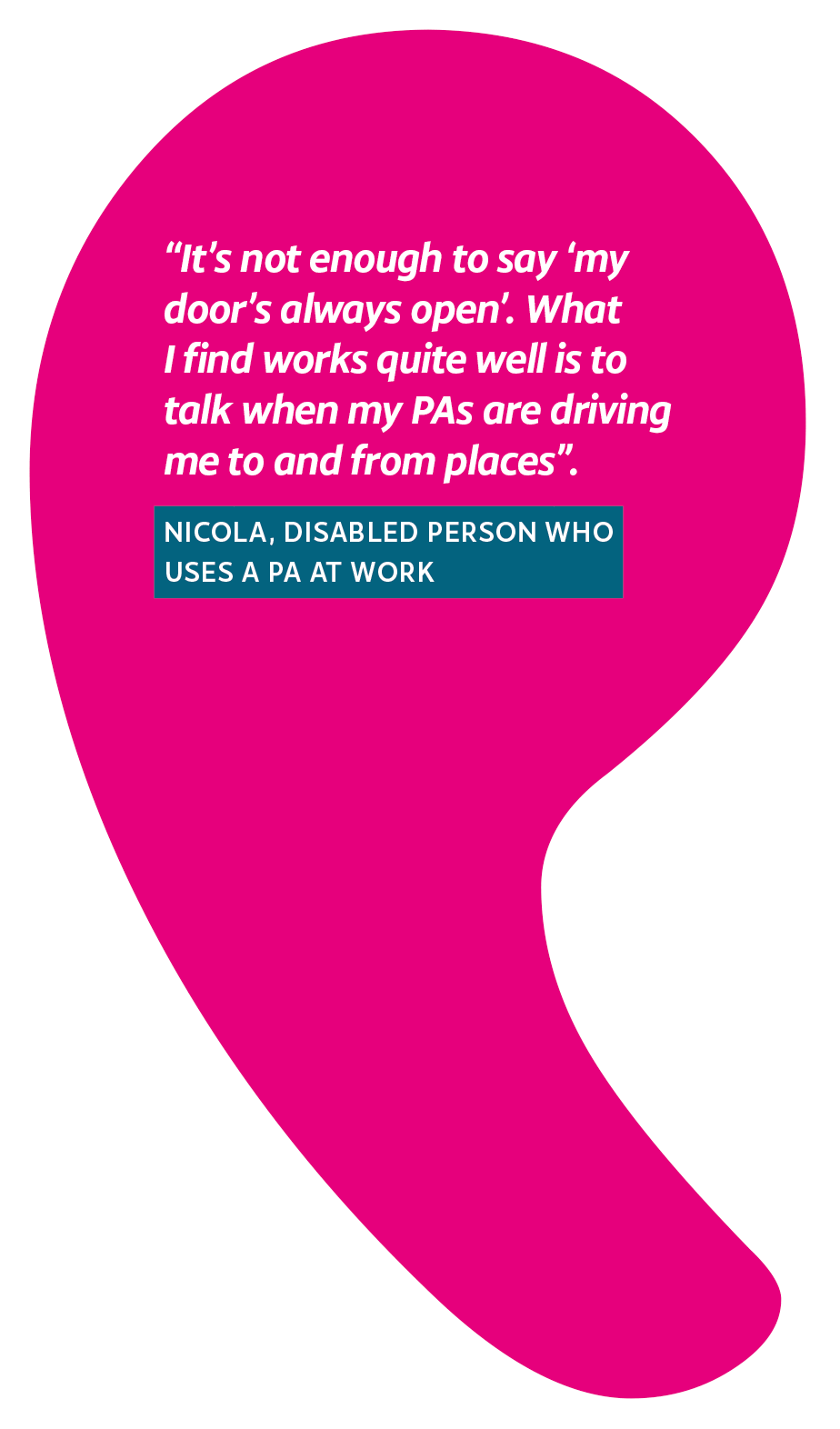Welcome...
Do you employ a personal assistant to support you at work? Are you a personal assistant supporting a disabled person in their workplace? Or do you employ a disabled person who has a workplace PA?
This website contains information about recruiting and training workplace PAs, negotiating and managing relationships in the workplace, and managing the expectations of colleagues. There are also tips for workplace PAs, and for employers who have disabled people with PAs in their teams.
This information has been developed from research with people with physical or sensory impairments, their employers, and their PAs, but may be useful to others too.
You can get more information about the research, or request a paper or braille copy of this guidance, by clicking here.
What do workplace PAs do?
Some PAs work only in the workplace, while others also support the disabled person at home, so need to adapt to these different settings.
While the specifics of a PA’s work are unique to each disabled person in their particular workplace, the role is to enable the disabled person to do their job. In doing so, the PA seeks to ensure that they remain in the background themselves.
This leaflet is based on research which explored the role of the workplace PA for people with physical or sensory impairments for the first time. The research involved in-depth conversations with workplace PAs, disabled people who use PAs in their workplaces and their line managers, and all three groups fed into the development of this document.
Working with a workplace PA
Be clear about the support you want from your workplace PA at work
- Clarify with your workplace personal assistant what you expect from them.
- Offer guidance and respond to problems or concerns as they arise.
- Don’t make assumptions about what your workplace PA does or doesn’t know, encourage them to ask you for guidance.
Supporting your workplace PA to feel part of the organisation
- Be open and honest with your line manager about the assistance you require.
- Pass on to your workplace PA any workplace developments affecting them and their work, for example changes to car parking arrangements.
- Speak to your line manager if your workplace PA does not have what they need to do their job, or if colleagues repeatedly use your PA as a general resource.
The role of a workplace PA is complex and needs managing
- Get to know your PA from the start and implement a probationary period.
- Think about your own management skills – would you benefit from further training, for example in supervision and maintaining boundaries between a professional relationship and a friendship?
- If you have more than one workplace PA, consider organising tasks to maximise their different skills and strengths.
- If you have workplace and home support from the same PA, clarify any different expectations in these settings, for example dress code or the PA joining in conversations.
Supervision is important, so make time for regular formal reviews
- Informal discussion is also useful – capitalise on opportunities (for instance travel time) to discuss how things are going and identify problems early.
Create clear boundaries – this is not always easy and may evolve over time
- Working one-to-one with your workplace PA can be intense, but it is important to keep professional boundaries.
Support your workplace personal assistant
- Workplace PAs value knowing what is going to happen, especially if your job involves different locations and travel. Share your work plan so that they can prepare, for example, for a particular dress code or a late finish.
- Workplace PAs are usually not part of the formal staff structure of the organisation. In turn your colleagues may be uncertain how to relate to your PA, especially if they have little prior experience. This can lead to your PA feeling isolated and out of place, making it harder for them to do their job well.
Useful conversations to have with your line manager
Before you start work
- Meet formally before you start work to clarify both your role (to manage your workplace PA) and the role of your line manager (to manage you).
- Discuss your workplace support needs.
- Ensure any reasonable adjustments are in place. If you are applying to the Department of Work and Pensions Access to Work scheme, put in your application as soon as possible. Remember to use the terminology used by Access to Work.
- Find out if any further support can be offered from the organisation, for example training if you are managing a workplace PA for the first time.
Expectations
- Clarify norms and expectations of the organisation, for example in relation to dress code and language use. Will your workplace PA be required to meet these expectations too?
Induction
- Can an induction be arranged for your workplace PA, at least covering fire evacuation procedure and ‘who does what’ in the organisation?
- Consider security – does access to the building or computer system need to be arranged for the PA?
Confidentiality and other relevant organisational policies
- Do you have to sign a confidentiality agreement as part of your job? How will you ensure that your workplace PA also adheres to this policy? For example, have you asked them to sign a confidentiality agreement with you?
Specific training
- Is any training required for a PA to understand and work in the specific environment, for example bespoke health and safety issues or computer systems?
Discuss how to manage colleagues’ expectations
- Ensure colleagues understand the unique role of the workplace PA and that they are not a general resource for the organisation.
- Clarify the appropriate level of formal interaction between the workplace PA and colleagues.
- Agree how these ground rules will be shared with close colleagues.
Useful conversations to have with your workplace PA
Discuss the job description in depth
- What are the main tasks for you and for your workplace PA? What skills will your workplace PA require?
Working hours
- Does your job involve flexible working? If so, what degree of flexibility do you require from your workplace PA?
- Are you likely to require your workplace PA to work overtime? How will this be arranged, and how much notice will be given?
- How is payment agreed and made?
Annual leave and sick leave
- How are holiday dates agreed? What happens when you take annual leave yourself?
- What happens if you or your workplace PA is sick?
Responsibilities
- Explain your responsibilities towards your workplace PA, and discuss their responsibilities and those of your line manager.
Interaction with colleagues in the workplace
- Think about how to introduce your PA to colleagues so they are aware of their role.
- Discuss the level of appropriate interaction your workplace PA should have with others in the workplace. For example when should your PA be involved in discussions and when should they stay quiet? You might think this is obvious, but it can be difficult for a PA to judge, so they may need guidance from you.
Think about how to manage the times when your PA is not directly needed
- Are you happy for your PA to stay in the room and read a book or look at their phone if not needed?
About the website and leaflet
This document is based on findings of a research project which explored for the first time the role of the workplace PA for people with physical or sensory impairments. The research involved in-depth conversations with workplace PAs, people who use PAs in the workplace and their line managers, and all three groups also fed into the development of this document.
The role of a workplace PA is of course specific to the needs of the person being supported, their job and the organisation in which they work. Nevertheless, the people involved in this research project felt that the complexities involved in the workplace setting, along with the lack of understanding and awareness of the role, meant that a general resource containing advice and tips would be useful as a guide, especially for people who use PAs in the workplace, workplace PAs and line managers who have little experience of working with PAs in the workplace.
This resource draws on the accounts of people with relevant experience, and aims to help workplace PAs, people who use PAs in the workplace and their line managers to consider a range of issues that are useful to discuss at the start and as working relationships evolve and develop.
Research team
Katie Graham (University of York)
Jenni Brooks (Sheffield Hallam University)
Jane Maddison (University of York)
Yvonne Birks (University of York)
We would like to thank everyone who took part in this project and the National Institute for Health Research School for Social Care Research for funding the project.





